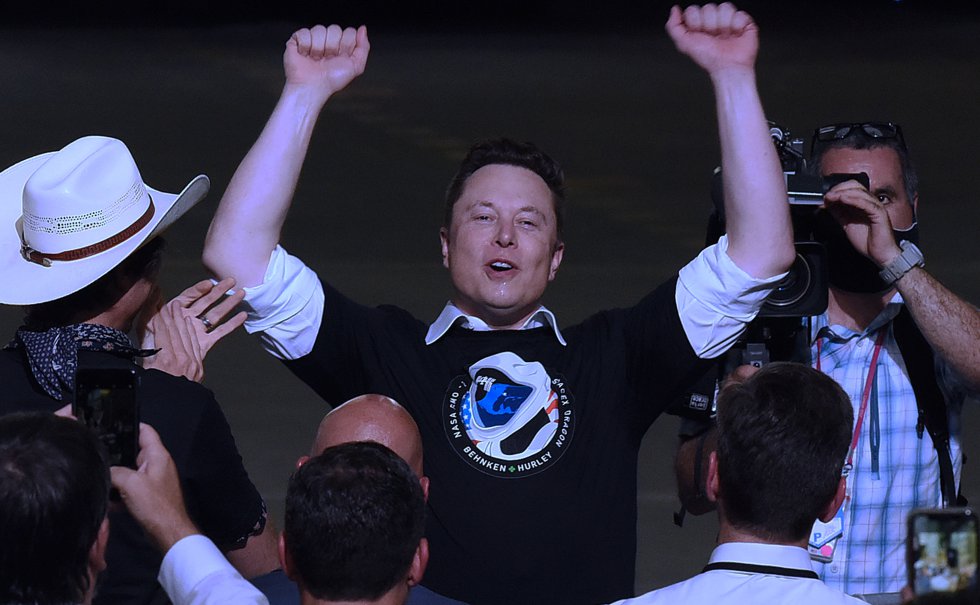
“It affects me a lot, but those who can cause problems are those who are dedicated to looking for comets, stars and others in telescopes, the serious thing is for science”, explains the astrophotographer Daniel Lopez. His eye-catching images of astronomical phenomena have been around the world, but on Tuesday night he ran into an unexpected problem when trying to photograph Comet Neowise from the peaks of Tenerife. As seen in the image, a platoon of SpaceX satellites, Elon Musk’s company, crossed in front of their target, perpetrating dozens of light scratches on their work. Musk intends to capitalize on his privileged access to Earth orbit with thousands of these devices, which will be an annoying eyelash in the eye of astronomers. “The proliferation of constellations of artificial satellites harms astronomical observation”, warns the Spanish Society of Astronomy (SEA).
Last week, during the SEA scientific meeting it was made public a job commissioned a scientific team to analyze the risks of these new satellite constellations that pose “a threat to astronomical observation.” Several companies such as Musk’s, which has pioneered his project StarlinkThey will fill the sky with devices that do not have among their priorities the damage they cause to science, astrophotography or exploration with future space junk. Lopez’s photo is a good example.
Musk’s project involves a swarm of at least 12,000 of these devices, weighing 260 kilos, that will completely surround the planet to make money in exchange for providing high-quality internet to their customers. For now has already released 540, which are located in the sky in colorful choreographies easily visible from the ground. Other billionaire, Jeff Bezos, plans to send some 3,000 satellites with the same purpose: to commercially exploit the sky. They should only ask permission to the American Communications Agency, which has nothing to do with scientific, astronomical or protection interests of a space that belongs to all humans.
“The impact for astronomy is practically the beginning of the end of the night”, warned the Nobel Prize winner in Physics Didier Queloz, “but the people who command these satellites do not care: they have never spoken with astronomers, or with the public” . “They are people commercializing the sky right now, they make money with it, and the consequence is that we are going to lose the sky”, Queloz sentenced, renowned astronomer who has discovered countless celestial bodies for science. Last year, there was a clash between the European Space Agency (ESA) and SpaceX, which had its aircraft at risk of collision with the scientific observation satellite Aeolus, forcing ESA to perform a “collision avoidance maneuver” for the first time. An episode that reopened the debate on spatial planning and the excessive ambition of these companies, but also on the lack of transparency of their initiatives.
“They are people commercializing the sky right now, they make money with it, and the consequence is that we are going to lose the sky”
Didier Queloz, Nobel Prize in Physics
Along with Musk’s and Bezos’s, there are similar projects from China and other private companies. “Should these projects culminate,” the SEA work warns, “the current number of artificial objects intentionally placed in orbit would more than double. These projects have considerable consequences ”. There are already several constellations of satellites, such as positioning ones such as GPS and Galileo, but they all add up to a small number of instruments, always below a hundred, astronomers explain. Some information suggests that only Starlink could deposit 42,000 satellites for SpaceX in low Earth orbit, where the International Space Station and the space telescope rest. Hubble.
The initial problem is that when the satellites periodically catch and reflect the sunlight, they interfere with observations of the sky, which is filled with annoying little mirrors at different heights, because the devices gradually move to their ideal position. This generated a great controversy among all the astronomical societies of the world, after which SpaceX promised that it would work on a series of changes that would make its future devices less annoying to look at.
Although that’s just one of the downsides. Astronomers look at the sky, but so do they listen with its gigantic radio telescopes, which capture signals caused by cosmic phenomena such as pulsars and galaxies, which emit radio waves. Telecommunications satellites emit and receive on frequencies that could interfere with those jobs, the study warns. “It must be stressed that the emissions from these systems will be present day and night, and that their intensity could not only make radio astronomical observations in the affected bands difficult, but even damage detectors designed to receive radiation from extremely weak natural sources”, alert.
The SEA study calculates many variables to study to what extent it would affect astronomical work and what the solutions would be. For example, telescopes could have alarms that warn that one of these objects is going to be crossed, but that would depend on an extraordinary exercise of transparency on the part of private companies. According to their analysis, the damage caused may not be as great as initially feared, when the satellites in very low orbits began to be filmed. But “wide-field projects”, such as the Vera Rubin Observatory, “can be greatly affected.” In February, the diagnosis of the International Astronomical Union was worse: “It is estimated that the traces of the satellite constellations will be bright enough to saturate modern detectors in large telescopes.” Astronomy will suffer, as will astrophotographers like Daniel López, who will have to get used to living with these impertinent artifacts.
You can write to us [email protected] or follow MATERIA on Facebook, Twitter, Instagram or subscribe here to our Newsletter.
https://news.google.com/__i/rss/rd/articles/CBMiSGh0dHBzOi8vcGxlZGdldGltZXMuY29tL3RoaXMtaXMtaG93LWVsb24tbXVza3Mtc2F0ZWxsaXRlcy1zcG9pbC10aGUtc2t5L9IBTGh0dHBzOi8vcGxlZGdldGltZXMuY29tL3RoaXMtaXMtaG93LWVsb24tbXVza3Mtc2F0ZWxsaXRlcy1zcG9pbC10aGUtc2t5L2FtcC8?oc=5
2020-08-19 14:45:11Z
52780999650947
Tidak ada komentar:
Posting Komentar